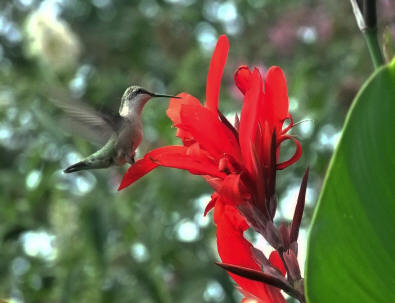
(5/13) The mystical lifestyle of a hummingbird can be enjoyed by learning how to provide an environment in your garden for them. Hummers provide entertainment for bird-watchers and are a photographer’s delight. It is crucial to work hard to attract hummingbirds to your garden environment because they have a spatial memory; and once you get them established, they will
be back again the next year.
There are sixteen varieties of hummingbirds in the United States, but the ruby-throated hummingbirds are the only hummingbirds east of the Mississippi River. A ruby-throat weighs approximately one-ninth of an ounce. In comparison, it doesn’t weigh as much as a nickel. A hummingbird at rest breathes four times per second and its heart beats 20 times per second. A
hummingbird can beat its wings 80 times per second.
Hummingbirds arrive in Pennsylvania in mid-April to early May. Annually we have a contest at our home to determine who witnesses the first appearance of a hummingbird. Our unscientific earliest sighting was May 1st.
 A male hummingbird is distinguished from the female by its metallic ruby- red throat. The female hummingbird has a white throat with occasional faint tan streaking. Juvenile male and female hummingbirds look similar. Males will usually get their full red gorgets along their throats during their first winter of
existence. A male hummingbird will mate with more than one female hummingbird. The female builds her nest five to twenty feet above the ground. The nest is the size of a walnut. Females return each year to the same areas and may reuse the old nests. She typically lays two eggs and incubates the eggs and raises the young without the assistance of the male. Their nests are
usually found in deciduous trees, and they like to be near a water source. They prefer being near trees and shrubs that will provide an area for protection.
A male hummingbird is distinguished from the female by its metallic ruby- red throat. The female hummingbird has a white throat with occasional faint tan streaking. Juvenile male and female hummingbirds look similar. Males will usually get their full red gorgets along their throats during their first winter of
existence. A male hummingbird will mate with more than one female hummingbird. The female builds her nest five to twenty feet above the ground. The nest is the size of a walnut. Females return each year to the same areas and may reuse the old nests. She typically lays two eggs and incubates the eggs and raises the young without the assistance of the male. Their nests are
usually found in deciduous trees, and they like to be near a water source. They prefer being near trees and shrubs that will provide an area for protection.
No other bird feeds on nectar as consistently as a hummingbird. They have long beaks and elongated tongues for consuming the nectar. They are territorial because their instinct is to guard their food source. Hummers fly backwards and forwards and hover. Flowering plants and hummingbirds complement each other because plants provide nectar, and hummingbirds provide
pollination. When the hummers feed on the nectar, the pollen sticks to their heads. When they go to the next flower, they transfer some of the pollen to that flower. Hummingbirds do not have a keen sense of smell and are attracted to flowers by their color and their tubular shape. Their color preferences are red, pink, and orange. Hummingbirds love native plants. With
careful planning, you can provide food for the hummingbirds from spring to fall. Feeders for the hummingbirds supplement their nutrition when there is no nectar from flowers to sustain the hummers. Be sure that the sugar water in the feeders gets changed every three to four days.
Avoid using any pesticides or insecticides. These chemicals can be harmful to the hummingbirds and also kill the insects that are an important source of hummingbird food.
Some springtime plants that are a magnet for hummingbirds are Columbine (Aquilegia), which comes in a variety of colors; Bleeding Heart (dicentra); and Virginia Bluebell (Mertensia Virginica). In the summer, hummingbirds cannot resist Phlox (phlox). The flowers and the scent are wonderful. Bee Balm (Monarda) is a must for any summer-blooming garden. My experience has
been that the favorite colors of the hummingbirds are red and raspberry. Other summer-blooming flowers that attract hummingbirds are Verbena (verbena); Salvia (Salvia), which can be a perennial or an annual, depending on the variety; Hollyhocks (Alcea); Coral Bells (Heuchera); and one of my favorites, Penstemon (Penstamon).
Cardinal flower (Lobelia Cardinalis); Lantana (Lantana); Canna Lilies; and Milkweed (Asclepias Tuberosa) provide nectar-rich blooms for the hummers in late summer.
Each fall our hummingbird friends leave Pennsylvania and migrate between southern Mexico and northern Panama. They know when it is time to migrate by the change in the length of daylight. During their migration, they fly nonstop 600 miles across the Gulf of Mexico to get to their destination. Remember to keep your feeders outside until the end of September so that
these wonderful birds can store enough energy to allow them to successfully migrate south.
The ruby-throats begin moving north as early as January. Once in North America, migration proceeds at an average rate of twenty miles a day.
Birdwatchers and gardeners who understand how to attract hummingbirds by satisfying their need for food, water, shelter, and nesting spots will be rewarded with hummingbirds in their backyards for many years.